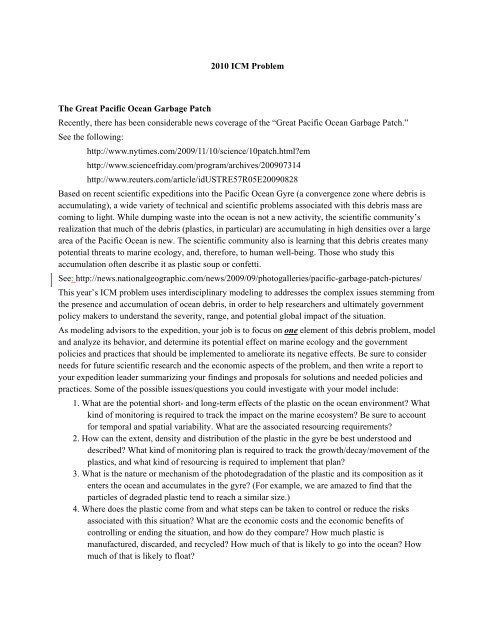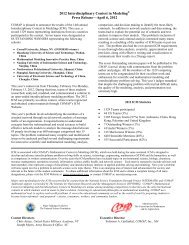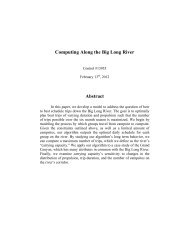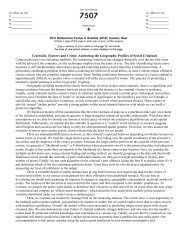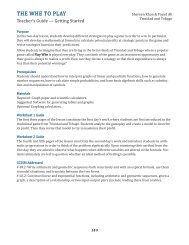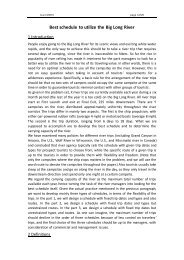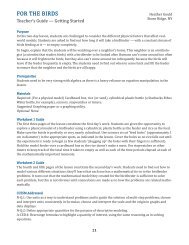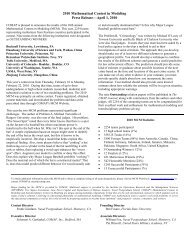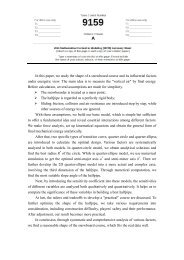You also want an ePaper? Increase the reach of your titles
YUMPU automatically turns print PDFs into web optimized ePapers that Google loves.
2010 ICM Problem<br />
<strong>The</strong> <strong>Great</strong> <strong>Pacific</strong> <strong>Ocean</strong> <strong>Garbage</strong> <strong>Patch</strong><br />
Recently, there has been considerable news coverage of the “<strong>Great</strong> <strong>Pacific</strong> <strong>Ocean</strong> <strong>Garbage</strong> <strong>Patch</strong>.”<br />
See the following:<br />
http://www.nytimes.com/2009/11/10/science/10patch.html?em<br />
http://www.sciencefriday.com/program/archives/200907314<br />
http://www.reuters.com/article/idUSTRE57R05E20090828<br />
Based on recent scientific expeditions into the <strong>Pacific</strong> <strong>Ocean</strong> Gyre (a convergence zone where debris is<br />
accumulating), a wide variety of technical and scientific problems associated with this debris mass are<br />
coming to light. While dumping waste into the ocean is not a new activity, the scientific community’s<br />
realization that much of the debris (plastics, in particular) are accumulating in high densities over a large<br />
area of the <strong>Pacific</strong> <strong>Ocean</strong> is new. <strong>The</strong> scientific community also is learning that this debris creates many<br />
potential threats to marine ecology, and, therefore, to human well-being. Those who study this<br />
accumulation often describe it as plastic soup or confetti.<br />
See: http://news.nationalgeographic.com/news/2009/09/photogalleries/pacific-garbage-patch-pictures/<br />
This year’s ICM problem uses interdisciplinary modeling to addresses the complex issues stemming from<br />
the presence and accumulation of ocean debris, in order to help researchers and ultimately government<br />
policy makers to understand the severity, range, and potential global impact of the situation.<br />
As modeling advisors to the expedition, your job is to focus on one element of this debris problem, model<br />
and analyze its behavior, and determine its potential effect on marine ecology and the government<br />
policies and practices that should be implemented to ameliorate its negative effects. Be sure to consider<br />
needs for future scientific research and the economic aspects of the problem, and then write a report to<br />
your expedition leader summarizing your findings and proposals for solutions and needed policies and<br />
practices. Some of the possible issues/questions you could investigate with your model include:<br />
1. What are the potential short- and long-term effects of the plastic on the ocean environment? What<br />
kind of monitoring is required to track the impact on the marine ecosystem? Be sure to account<br />
for temporal and spatial variability. What are the associated resourcing requirements?<br />
2. How can the extent, density and distribution of the plastic in the gyre be best understood and<br />
described? What kind of monitoring plan is required to track the growth/decay/movement of the<br />
plastics, and what kind of resourcing is required to implement that plan?<br />
3. What is the nature or mechanism of the photodegradation of the plastic and its composition as it<br />
enters the ocean and accumulates in the gyre? (For example, we are amazed to find that the<br />
particles of degraded plastic tend to reach a similar size.)<br />
4. Where does the plastic come from and what steps can be taken to control or reduce the risks<br />
associated with this situation? What are the economic costs and the economic benefits of<br />
controlling or ending the situation, and how do they compare? How much plastic is<br />
manufactured, discarded, and recycled? How much of that is likely to go into the ocean? How<br />
much of that is likely to float?
5. Could similar situations develop in other places in the oceans? What should we monitor and how?<br />
What is happening in the North Atlantic Gyre and the Alaskan Gyre? Use your model to estimate<br />
the plastic density in the future in the southern gyres (South Atlantic, South <strong>Pacific</strong>)?<br />
6. What is the immediate impact of banning polystyrene takeout containers? (See:<br />
http://bit.ly/5koJHB) What is the impact over 10–50 years?<br />
7. Any other scientific/technological issue associated with this situation is also acceptable, as long as<br />
modeling is an important component of your investigation and analysis.<br />
To clarify your task, focus on one critical aspect of this problem and model the behavior of the important<br />
matters or phenomena. Specify the quantities that are of greatest present or future interest to the one<br />
aspect you choose to model and analyze. Your ICM report should be in the form of a ten-page team<br />
report to an expedition leader who has asked you to help her identify the relevant behaviors of the matters<br />
and phenomena under consideration, provide the analysis for impact of the behavior of those matters or<br />
phenomena, and advise her on the government’s potential to act on the problem to improve this situation<br />
before it worsens.<br />
<strong>The</strong> following files contain some helpful data:<br />
CountDensity1999‐2009.pdf; Moore 2001.pdf; Yamashita 2007.pdf<br />
Here are some suggested papers you can use to inform your model formulation and obtain more<br />
data:<br />
Note: As a reminder, it is best to stick to the scientific literature, not the media coverage, for your facts.<br />
<strong>The</strong> mainstream media coverage of this issue has been misleading in many cases. For further explanation,<br />
see: http://seaplexscience.com/2009/11/13/millions-billions-trillions-of-scientific-errors-in-the-nyt/<br />
Committee on the Effectiveness of International and National Measures to Prevent and Reduce Marine<br />
Debris and Its Impacts (National Research Council). (2009). Tackling Marine Debris in the 21st<br />
Century, National Academies Press, Washington D.C.<br />
Dameron, O.J., Parke, M., Albins M.A., and Brainard R. (2007). Marine debris accumulation in the<br />
Northwestern Hawaiian Islands: An examination of rates and processes. Marine Pollution Bulletin,<br />
54:423–433.<br />
Derraik, J.G.B. (2002). <strong>The</strong> pollution of the marine environment by plastic debris: a review. Marine<br />
Pollution Bulletin, 44:842–852.<br />
Matsumura, S., and Nasu, K. (1997). Distribution of floating debris in the north <strong>Pacific</strong> <strong>Ocean</strong>: sighting<br />
surveys 1986–1991. In: Coe, J. and Rogers, D. (eds.). Marine Debris: Sources, Impacts and Solutions.<br />
Springer, New York, pp. 15–24.<br />
Moore, C.J., Moore, S.L., Leecaster, M.K., and Weisberg, S.B. (2001). A comparison of plastic and<br />
plankton in the North <strong>Pacific</strong> central gyre. Marine Pollution Bulletin, 42:1297–1300.<br />
Pichel, W.G., Churnside, J.H., Veenstra, T.S., Foley, D.G., Friedman, K.S., Brainard, R.E., Nicoll, J.B.,<br />
Zheng, Q., and Clemente-Colon, P. (2007). Marine debris collects within the North <strong>Pacific</strong> Subtropical<br />
Convergence Zone. Marine Pollution Bulletin, 54:1207–1211.
Robards, M.D., Gould, P., Platt, J. (1997). <strong>The</strong> highest global concentrations and increased abundance of<br />
oceanic plastic debris in the North <strong>Pacific</strong>: evidence from seabirds. In: Coe J. and Rogers, D. (eds.)<br />
Marine Debris: Sources, Impact and Solutions. Springer, New York, pp. 15–24.<br />
Venrick, E.L., Backman, T.W., Bartram, W.C., Platt, C.J., Thornhill, M.S., and Yates, R.E. (1973). Manmade<br />
objects on the surface of the central north pacific ocean. Nature, 241:271–271.<br />
Yamashita, R., Tanimura, A. (2007). Floating plastic in the Kuroshio Current area, western North <strong>Pacific</strong><br />
<strong>Ocean</strong>. Marine Pollution Bulletin, 54:485–488.
PII: S0025-326X01)00114-X<br />
Marine Pollution Bulletin Vol. 42, No. 12, pp. 1297±1300, 2001<br />
Ó 2001 Elsevier Science Ltd. All rights reserved<br />
Printed in <strong>Great</strong> Britain<br />
0025-326X/01 $ - see front matter<br />
A Comparison of Plastic and Plankton<br />
in the North Paci®c Central Gyre<br />
C. J. MOORE *, S. L. MOORE , M. K. LEECASTERà ,1 and S. B. WEISBERGà<br />
Algalita Marine Research Foundation, 345 Bay Shore Avenue, Long Beach, CA 90803, USA<br />
àSouthern California Coastal Water Research Project, 7171 Fenwick Lane, Westminster, CA 92683, USA<br />
<strong>The</strong> potential for ingestion of plastic particles by open<br />
ocean ®lter feeders was assessed by measuring the relative<br />
abundance and mass of neustonic plastic and zooplankton<br />
in surface waters under the central atmospheric highpressure<br />
cells of the North Paci®c <strong>Ocean</strong>. Neuston samples<br />
were collected at 11 random sites, using a manta<br />
trawl lined with 333 u mesh. <strong>The</strong> abundance and mass of<br />
neustonic plastic was the largest recorded anywhere in the<br />
Paci®c <strong>Ocean</strong> at 334 271 pieces km 2 and 5114 gkm 2 ,<br />
respectively. Plankton abundance was approximately ®ve<br />
times higher than that of plastic, but the mass of plastic<br />
was approximately six times that of plankton. <strong>The</strong> most<br />
frequently sampled types of identi®able plastic were thin<br />
®lms, polypropylene/mono®lament line and unidenti®ed<br />
plastic, most of which were miscellaneous fragments.<br />
Cumulatively, these three types accounted for 98% of the<br />
total number of plastic pieces. Ó 2001 Elsevier Science<br />
Ltd. All rights reserved.<br />
Keywords: North Paci®c central gyre; neuston; plastics;<br />
zooplankton; debris; pollution monitoring.<br />
Marine debris is more than an aestheticproblem, posing<br />
a danger to marine organisms through ingestion and<br />
entanglement Day, 1980; Balazs, 1985; Fowler, 1987;<br />
Ryan, 1987; Robards, 1993; Bjorndal et al., 1994; Laist,<br />
1997). <strong>The</strong> number of marine mammals that die each<br />
year due to ingestion and entanglement approaches<br />
100 000 in the North Paci®c <strong>Ocean</strong> alone Wallace,<br />
1985). Worldwide, 82 of 144 bird species examined<br />
contained small debris in their stomachs, and in many<br />
species the incidence of ingestion exceeds 80% of the<br />
individuals Ryan, 1990). In addition, a recent study has<br />
determined that plastic resin pellets accumulate toxic<br />
chemicals, such as PCBs, DDE, and nonylphenols, and<br />
may serve as a transport medium and source of toxins to<br />
marine organisms that ingest them Mato et al., 2001).<br />
Many studies have focused on the ingestion of small<br />
debris by birds because their stomach contents can be<br />
regurgitated by researchers in the ®eld without causing<br />
*Corresponding author.<br />
1 Present address: INEEL, Bechtel WBXT, Idaho, LLC, P.O. Box<br />
1625, Idaho Falls, ID 83415-3779, USA.<br />
harm to the animal. Less well studied are the e€ects of<br />
ingestible debris on ®sh, and no studies have been conducted<br />
on ®lter-feeding organisms, whose feeding<br />
mechanisms do not permit them to distinguish between<br />
debris and plankton. Moreover, no studies have compared<br />
the amount of neustonicdebris to that of plankton<br />
to assess the potential e€ects on ®lter feeders.<br />
Concerns about the e€ects of neustonic debris in the<br />
marine environment are greatest in oceanographic convergences<br />
and eddies, where debris fragments naturally<br />
accumulate Shaw and Mapes, 1979; Day, 1986; Day and<br />
Shaw, 1987). <strong>The</strong> North Paci®c central gyre, an area of<br />
high atmospheric pressure with a clockwise ocean current,<br />
is one such area of convergence that forces debris<br />
into a central area where winds and currents diminish.<br />
This study compares the abundance and mass of neustonicdebris<br />
with the amount of zooplankton in this area.<br />
Materials and Methods<br />
Eleven neuston samples were collected between August<br />
23 and 26, 1999, from an area near the central pressure<br />
cell of the North Paci®c sub tropical high Fig. 1).<br />
Sampling sites were located along two transects: a<br />
westerly transect from 35°45.8 0 N, 138°30.7 0 W to<br />
36°04.9 0 N, 142°04.6 0 W; and a southerly transect from<br />
36°04.9 0 N, 142°04.6 0 Wto34°40.0 0 N. Location along the<br />
transect and trawl duration were selected randomly.<br />
Samples were collected using a manta trawl with a<br />
rectangular opening of 0:9 0:15 m 2 , and a 3.5 m long,<br />
333 u net with a 30 10 cm 2 collecting bag. <strong>The</strong> net was<br />
towed at the surface outside of the e€ects of port wake<br />
from the stern of the vessel) at a nominal speed of<br />
1ms 1 ; actual speed varied between 0.5 and 1.5 m s 1 ,<br />
as measured with a B&G paddlewheel sensor. Each<br />
trawl was conducted for a random distance, ranging<br />
from 5 to 19 km. Sampling was conducted as the ship<br />
moved along the transect with an approximately even<br />
split of sampling between daylight and night-time hours.<br />
Estimates of plasticand plankton per square kilometer<br />
were obtained by using the width of the trawl net<br />
opening times the length of the trawl.<br />
Samples were ®xed in 5% formalin, then soaked in<br />
fresh water and transferred to 50% isopropyl alcohol.<br />
1297
Marine Pollution Bulletin<br />
Fig. 1 Location of sampling area in the North Paci®c gyre.<br />
To separate the plasticparticles from living tissue, the<br />
samples were drained and put in seawater, which ¯oated<br />
most of the plasticto the surface, leaving the living tissue<br />
at the bottom. Top and bottom portions were inspected<br />
under a dissecting microscope. Intermixed<br />
plasticwas removed from the tissue fraction and tissue<br />
was removed from the plastic fraction and placed in the<br />
appropriate containers. Plankton were counted and<br />
identi®ed to class.<br />
Plasticwas sorted by rinsing through Tyler sieves of<br />
4.76, 2.80, 1.00, 0.71, 0.50, and 0.35 mm. Plasticand<br />
plankton were oven dried at 65°C for 24 h and weighed.<br />
Individual pieces of plastic were categorized into<br />
standardized categories by type fragment, Styrofoam<br />
fragment, pellet, polypropylene/mono®lament line<br />
fragment, thin plastic®lms), and one nonplasticcategory<br />
tar); then they were counted.<br />
Results<br />
A total of 27 698 small pieces of plastic weighing 424 g<br />
were collected from the surface water at stations in the<br />
gyre, yielding a mean abundance of 3 34271 pieces km 2<br />
and a mean mass of 5114 g=km 2 . Abundance ranged<br />
from 31 982 pieces km 2 to 969 777 pieces=km 2 , and mass<br />
ranged from 64 to 30169 gkm 2 .<br />
A total of 152 244 planktonicorganisms weighing<br />
approximately 70 g were collected from the surface water,<br />
with a mean abundance of 1837342 organisms km 2<br />
and mean mass of 841 g=km 2 dry weight). Abundances<br />
ranged from 54003 organisms km 2 to 50 76 403 organisms<br />
km 2 , and weights ranged from 74 to 1618 g=km 2 .<br />
Plastic fragments accounted for the majority of the<br />
material collected in the smaller size categories Table<br />
1). Thin plastic ®lms, such as those used in sandwich<br />
bags, accounted for half of the abundance in the second<br />
largest size category, and pieces of line polypropylene<br />
and mono®lament) comprised the greatest fraction of<br />
the material collected in the largest size category.<br />
Plankton abundance was higher than plastic abundance<br />
in 8 out of 11 samples, with the di€erence being<br />
higher at night Fig. 2). In contrast, the mass of plastic<br />
was higher than the plankton mass in 6 out of 11 samples.<br />
<strong>The</strong> ratio of plastic-to-plankton mass was higher<br />
Mesh-size<br />
mm)<br />
TABLE 1<br />
Abundance pieces km 2 ) by type and size of plastic pieces and tar found in the North Paci®c gyre.<br />
Fragments<br />
Styrofoam<br />
pieces<br />
Pellets<br />
Polypropylene/<br />
mono®lament<br />
Thin plastic<br />
®lms<br />
Miscellaneous<br />
Tar Unidenti®ed Total<br />
>4.760 1931 84 36 16 811 5322 217 350 24 764<br />
4.759±2.800 4502 121 471 4839 9631 97 36 19 696<br />
2.799±1.000 61 187 1593 12 9969 40 622 833 72 114 288<br />
0.999±0.710 55 780 591 0 2933 26 273 278 48 85 903<br />
0.709±0.500 45 196 567 12 1460 10 572 121 0 57 928<br />
0.499±0.355 26 888 338 0 845 3222 169 229 31 692<br />
Total 195 484 3295 531 36 857 95 642 1714 736 334 270<br />
1298
Volume 42/Number 12/December 2001<br />
Fig. 2 Abundance and mass of plankton and plastic in night versus<br />
day samples.<br />
during the day than at night, although much of the<br />
di€erence during the day was due to a plastic bottle<br />
being caught in one daylight sample and 1 m of polypropylene<br />
line being caught in the other.<br />
Discussion<br />
<strong>The</strong> mean abundance and weight of plastic pieces<br />
calculated for this study are the largest observed in the<br />
North Paci®c <strong>Ocean</strong>. Previous studies have estimated<br />
mean abundances of plastic pieces ranging from 3370 to<br />
96100 pieces km 2 and mean weights ranging from 46 to<br />
1210 gkm 2 Day and Shaw, 1987). <strong>The</strong> highest previous<br />
single sample abundance and weight recorded for the<br />
North Paci®c <strong>Ocean</strong> was taken from an area about 500<br />
miles east of Japan. At 316800 pieces km 2 and<br />
3492 gkm 2 Day et al., 1990), the abundance and<br />
weight are three and seven times less than the highest<br />
sample recorded in this study, respectively.<br />
Several possible reasons are suggested for the high<br />
abundance found in this study. <strong>The</strong> ®rst is the location<br />
of our study area, which was near the central of the<br />
North Paci®c subtropical high pressure cell. Previous<br />
studies in the North Paci®c <strong>Ocean</strong> were conducted<br />
without reference to the central pressure cell Day et al.,<br />
1990), which should serve as a natural eddy system to<br />
concentrate neustonic material including plastic. However,<br />
while previous studies did not focus on the subtropical<br />
high, many studies were conducted as transects<br />
that passed through the gyre Day et al., 1986, 1988,<br />
1990). Thus, it is unlikely that location alone was the<br />
reason for the higher densities we observed, as Day et al.<br />
1990) collected samples from the western part of this<br />
same area.<br />
An alternate hypothesis is that the amount of plastic<br />
material in the ocean is increasing over time, which Day<br />
and Shaw 1987) have previously suggested based upon<br />
a review of historical studies. Plastic degrades slowly in<br />
the ocean Andrady, 1990; US EPA, 1992). While some<br />
of the larger pieces may accumulate enough fouling<br />
organisms to sink them, the smaller pieces are usually<br />
free of fouling organisms and remain a¯oat. Thus, new<br />
plastics added to the ocean may not exit the system once<br />
introduced unless they are washed ashore. Although<br />
numerous studies have shown that islands are repositories<br />
of marine debris Lucas, 1992; Corbin and Singh,<br />
1993; Walker et al., 1997), the North Paci®c <strong>Ocean</strong> has<br />
few islands except near coastal boundaries. <strong>The</strong> dominant<br />
clockwise gyral currents also serve as a retention<br />
mechanism that inhibits plastics from moving toward<br />
mainland coasts. A recent surface current modeling<br />
study simulated that most of the particles from our<br />
sampling area should be retained there for at least 12<br />
years Ingraham et al., in press).<br />
<strong>The</strong> large ratio of plasticto plankton found in this<br />
study has the potential to a€ect many types of biota.<br />
Most susceptible are the birds and ®lter feeders that<br />
focus their feeding activities on the photic portion of the<br />
water column. Many birds have been examined and<br />
found to contain small debris in their stomachs, a result<br />
of their mistaking plasticfor food Day et al., 1985; Fry<br />
et al., 1987; Ainley et al., 1990; Ogi, 1990; Ryan, 1990;<br />
Laist, 1997). While no record was kept of the presence<br />
or absence of fouling organisms on plastic particles<br />
during sorting, a subsequent random sampling of each<br />
size class found 91.5% of the particles to be free of<br />
fouling organisms. As the size class decreased, there<br />
were fewer particles that showed evidence of fouling.<br />
Hence ingestion of plastic for its attached food seems<br />
unlikely, especially for organisms feeding on the surface.<br />
However, organisms such as the two ®lter-feeding salps<br />
<strong>The</strong>tys vagina) collected in this study which were found<br />
to have plasticfragments and polypropylene/mono®lament<br />
line ®rmly embedded in their tissues, may have<br />
ingested the line at depth and utilized fouling organisms<br />
for food.<br />
Although our study focused on the neuston, samples<br />
also were collected from two oblique tows to a depth of 10<br />
m. We found that the density of plasticin these areas was<br />
less than half of that in the surface waters and was primarily<br />
limited to mono®lament line that had been fouled<br />
by diatoms and microalgae, thereby reducing its buoyancy.<br />
<strong>The</strong> smaller particles that have the greatest potential<br />
to a€ect ®lter feeders were even more reduced with<br />
depth, as should be expected because of their positive<br />
buoyancy and lack of fouling organisms, noted above.<br />
Several limitations restrict our ability to extrapolate<br />
our ®ndings of high plastic-to-plankton ratios in the<br />
1299
Marine Pollution Bulletin<br />
North Paci®c central gyre to other areas of the ocean.<br />
<strong>The</strong> North Paci®c <strong>Ocean</strong> is an area of low biological<br />
standing stock; plankton populations are many times<br />
higher in nearshore areas of the eastern Paci®c, where<br />
upwelling fuels productivity McGowan et al., 1996).<br />
Moreover, the gyre beneath the subtropichigh probably<br />
serves to retain plastics, whereas plastics may wash up<br />
on shore in greater numbers in other areas. Conversely,<br />
areas closer to the shore are more likely to receive inputs<br />
from land-based runo€ and ship loading and unloading<br />
activities, whereas a large fraction of the materials observed<br />
in this study appear to be remnants of o€shore<br />
®shing-related activity and shipping tra c.<br />
<strong>The</strong> authors wish to thank the Algalita Marine Research Foundation<br />
for the use of its charter of the <strong>Ocean</strong>ographic Research Vessel,<br />
ALGUITA. We thank Dr Curtis Ebbesmeyer the Beachcombers' and<br />
<strong>Ocean</strong>ographers' International Association), W. James Ingraham, Jr.<br />
US National <strong>Ocean</strong>ic and Atmospheric Administration), and Chuck<br />
Mitchell MBC Applied Environmental Sciences) for their advice in<br />
the design and interpretation of the study. We thank the following<br />
individuals for their assistance in data collection: Mike Baker, John<br />
Barth, Robb Hamilton, and Steve McLeod. We also thank Ann Zellers<br />
for her help with sample processing.<br />
Ainley, D. G., Spear, L. B. and Ribic, C. A. 1990) <strong>The</strong> incidence of<br />
plasticin the diets of pelagicseabirds in the eastern equatorial<br />
Paci®c region. In Proceedings of the Second International Conference<br />
on Marine Debris, eds. R. S. Shomura and M. L. Godfrey, pp. 653±<br />
664. April 2±7, 1989. Honolulu, Hawaii. US Department of<br />
Commerce, NOAA Technical Memorandum NMFS, NOAA-TM-<br />
NMFS-SWFC-154.<br />
Andrady, A. L. 1990) Environmental degradation of plastics under<br />
land and marine exposure conditions. In Proceedings of the Second<br />
International Conference on Marine Debris, eds. R. S. Shomura and<br />
M. L. Godfrey, pp. 848±869. April 2±7, 1989. Honolulu, Hawaii.<br />
US Department of Commerce, NOAA Technical Memorandum<br />
NMFS, NOAA-TM-NMFS-SWFC-154.<br />
Balazs, G. H. 1985) Impact of ocean debris on marine turtles:<br />
Entanglement and ingestion. In Proceedings of the Workshop on the<br />
Fate and Impact of Marine Debris, eds. R. S. Shomura and H. O.<br />
Yoshida, pp. 387±429. US Department of Commerce, NOAA<br />
Technical Memorandum NMFS, NOAA-TM-NMFS-SWFC-54.<br />
Bjorndal, K. A., Bolton, A. B. and Lagueux, C. J. 1994) Ingestion of<br />
marine debris by juvenile sea turtles in coastal Florida habitats.<br />
Marine Pollution Bulletin 28, 154±158.<br />
Corbin, C. J. and Singh, J. G. 1993) Marine debris contamination of<br />
beaches in St. Lucia and Dominica. Marine Pollution Bulletin 26,<br />
325±328.<br />
Day, R. H. 1980) <strong>The</strong> occurrence and characteristics of plastic<br />
pollution in Alaska's marine birds. M.S. <strong>The</strong>sis, University of<br />
Alaska. Fairbanks, AK, 111 pp.<br />
Day, R. H. 1986) Report on the Cruise of the Pusan 851 to the North<br />
Paci®c <strong>Ocean</strong>, July±August 1986. Final Report to National <strong>Ocean</strong>ic<br />
and AtmosphericAdministration, National Marine Fisheries Service,<br />
Auke Bay Laboratory. Auke Bay, AK, 93 pp.<br />
Day, R. H. 1988) Quantitative distribution and characteristics of<br />
neustonic plastic in the North Paci®c <strong>Ocean</strong>. Final Report to US<br />
Department of Commerce, National Marine Fisheries Service,<br />
Auke Bay Laboratory. Auke Bay, AK, 73 pp.<br />
Day, R. H., Clausen, D. M. and Ignell, S. E. 1986) Distribution and<br />
Density of Plastic Particulates in the North Paci®c <strong>Ocean</strong> in 1986.<br />
Submitted to the International North Paci®c Fisheries Commission,<br />
Anchorage, Alaska, November 1986, 17 pp. Northwest and Alaska<br />
Fisheries Center, Nattional Marine Fisheries Services, National<br />
<strong>Ocean</strong>ic Atmospheric Administration, Auke Bay Laboratory, P.O.<br />
Box 210155, Auke Bay, AK 99821.<br />
Day, R. H. and Shaw, D. G. 1987) Patterns in the abundance of<br />
pelagic plastic and tar in the North Paci®c <strong>Ocean</strong>, 1976±1985.<br />
Marine Pollution Bulletin 18, 311±316.<br />
Day, R. H., Shaw, D. G. and Ignell, S. E. 1990) <strong>The</strong> quantitative<br />
distribution and characteristics of neuston plastic in the North<br />
Paci®c <strong>Ocean</strong>, 1984±1988. In Proceedings of the Second International<br />
Conference on Marine Debris, eds. R. S. Shomura and M. L.<br />
Godfrey, pp. 247±266. April 2±7, 1989. Honolulu, Hawaii. US<br />
Department of Commerce, NOAA Technical Memorandum<br />
NMFS, NOAA-TM-NMFS-SWFC-154.<br />
Day, R. H., Wehle, D. H. S. and Coleman, F. C. 1985) Ingestion of<br />
plasticpollutants by marine birds. In Proceedings of the Workshop<br />
on the Fate and Impact of Marine Debris, eds. R. S. Shomura and H.<br />
O. Yoshida, pp. 344±386. US Department of Commerce, NOAA<br />
Technical Memorandum NMFS, NOAA-TM-NMFS-SWFC-54.<br />
Fowler, C. W. 1987) Marine debris and northern fur seals: a case<br />
study. Marine Pollution Bulletin 18, 326±335.<br />
Fry, D. M., Fefer, S.I. and Sileo, L. 1987) Ingestion of plasticdebris<br />
by Laysan albatrosses and wedge-tailed shearwaters in the Hawaiian<br />
Islands. Marine Pollution Bulletin 18, 339±343.<br />
Ingraham, W. James Jr. and Curtis Ebbesmeyer in press). In<br />
Proceedings of the Fourth Marine Debris Conference. Honolulu,<br />
HI, August 7±11, 2000. NOAA-National <strong>Ocean</strong> Survey, National<br />
Marine Sanctuary, Technical Memorandum.<br />
Laist, D. W. 1997) Impacts of marine debris: entanglement of marine<br />
life in marine debris including a comprehensive list of species with<br />
entanglement and ingestion records. In Marine Debris: Sources,<br />
Impacts, and Solutions., eds. J. M. Coe and D. B. Rogers, pp. 99±<br />
140. Springer. New York.<br />
Lucas, Z. 1992) Monitoring persistent litter in the marine environment<br />
on Sable Island, Nova Scotia. Marine Pollution Bulletin 24,<br />
192±199.<br />
Mato, Y., Isobe, T., Takada, H., Kanehiro, H., Ohtake, C. and<br />
Kaminuma, T. 2001) Plasticresin pellets as a transport medium for<br />
toxic chemicals in the marine environment. Environmental Science<br />
Technology 35, 318±324.<br />
McGowan, J. A., Chelton, D. B. and Conversi, A. 1996) Plankton<br />
patterns, climate and change in the California Current. California<br />
Cooperative <strong>Ocean</strong>ic Fisheries Investment Report 37, 45±68.<br />
Ogi, H. 1990) Ingestion of plasticparticles by sooty and short-tailed<br />
shearwaters in the North Paci®c. In Proceedings of the Second<br />
International Conference on Marine Debris, eds. R. S. Shomura and<br />
M. L. Godfrey, pp. 635±652. April 2±7, 1989. Honolulu, Hawaii.<br />
US Department of Commerce, NOAA Technical Memorandum<br />
NMFS, NOAA-TM-NMFS-SWFC-154.<br />
Robards, M. D. 1993) Plastic Ingestion by North Paci®c Seabirds. US<br />
Department of Commerce, NOAA-43ABNF203014, Washington,<br />
DC.<br />
Ryan, P. G. 1987) <strong>The</strong> e€ects of ingested plastic on seabirds:<br />
correlations between plastic load and body condition. Environmental<br />
Pollution 46, 119±125.<br />
Ryan, P. G. 1990) <strong>The</strong> e€ects of ingested plastic and other marine<br />
debris on seabirds. In Proceedings of the Second International<br />
Conference on Marine Debris, eds. R. S. Shomura and M. L.<br />
Godfrey, pp. 623±634. April 2±7, 1989. Honolulu, Hawaii. US<br />
Department of Commerce, NOAA Technical Memorandum,<br />
NMFS, NOAA-TM-NMFS-SWFC-154.<br />
Shaw, D. G. and Mapes, G. A. 1979) Surface circulation and the<br />
distribution of pelagictar and plastic. Marine Pollution Bulletin 10,<br />
160±162.<br />
U.S. Environmental Protection Agency US EPA) 1992) Plastic<br />
Pellets in the Aquatic Environment: Sources and Recommendations.<br />
Washington, DC, EPA 842-B-92-010.<br />
Wallace, N. 1985) Debris entanglement in the marine environment: a<br />
review. In Proceedings of the Workshop on the Fate and Impact of<br />
Marine Debris, eds. R. S. Shomura and H. O. Yoshida, pp. 259±<br />
277. US Department of Commerce, NOAA Technical Memorandum,<br />
NMFS, NOAA-TM-NMFS-SWFC-54.<br />
Walker, T. R., Reid, K., Arnould, J. P. Y. and Croxall, J. P. 1997)<br />
Marine debris surveys at Bird Island, South Georgia 1990±1995.<br />
Marine Pollution Bulletin 34, 61±65.<br />
1300
Baseline / Marine Pollution Bulletin 54 (2007) 464–488 485<br />
Connell, D.W., Wu, R.S.S., Richardson, B.J., Leung, K., Lam, P.S.K.,<br />
Connell, P.A., 1998. Occurrence of persistent organic contaminants<br />
and related substances in Hong Kong marine areas: an overview.<br />
Marine Pollution Bulletin 36, 376–384.<br />
Fujii, M., 1976. Mercury distribution in lithosphere and atmosphere. In:<br />
Kitamura, S., Kondo, M., Takizawa, Y., Fujii, M., Fujiki, M. (Eds.),<br />
Mercury. Kodansha Scientific, Tokyo.<br />
Gilmour, C.C., Bloom, N.S., 1995. A case study of mercury and<br />
methylmercury dynamics in a Hg-contaminated municipal waste-water<br />
treatment plant. Water, Air, and Soil Pollution 80, 799–803.<br />
Hines, M.E., Horvat, M., Faganeli, J., Bonzongo, J.-C.J., Barkay, T.,<br />
Major, E.B., Scott, K.J., Bailey, E.A., Warwick, J.J., Lyons, W.B.,<br />
2000. Mercury biogeochemistry in the Idrija River, Slovenia, from<br />
above the mine into the Gulf of Trieste. Environmental Research<br />
Section A 83, 129–139.<br />
HK CSD, 2006. Official statistics on Population and Vital Events. HK<br />
Census and Statistics Department, pp. 3.<br />
HK EPD, 2004. Marine water quality in Hong Kong. Environmental<br />
Protection Department, Hong Kong Government, pp. 6.13.<br />
HK ETWB, 2002. Management of dredged/excavated sediment. Appendix<br />
A of ETWB (W) No. 34, Environment, Transport and Works Bureau,<br />
Hong Kong, pp. A1.<br />
Hong Kong Government, 1995. <strong>The</strong> shape of things to come – an<br />
overview of the role of harbour reclamation in the future development<br />
of Hong Kong. Hong Kong Government: Planning, Environmental<br />
and Lands Branch, pp. 136.<br />
Horvat, M., Covelli, S., Faganeli, J., Logar, M., Mandić, V., Rajar, R.,<br />
Širca, A., Žagar, D., 1999. Mercury in contaminated coastal environments;<br />
a case study: the Gulf of Trieste. Science of the Total<br />
Environment 237/238, 43–56.<br />
Kannan, K., Falandysz, J., 1998. Speciation and concentrations of<br />
mercury in certain coastal marine sediment. Water, Air, and Soil<br />
Pollution 103, 129–136.<br />
Kannan, K., Smith, J.R.G., Lee, R.F., Windom, H.L., Heitmuller, P.T.,<br />
Macauley, J.M., Summers, J.K., 1998. Distribution of total mercury<br />
and methyl mercury in water, sediment and fish from South Florida<br />
Estuaries. Archives of Environment Contamination and Toxicology<br />
34, 109–118.<br />
Liang, L.N., Jiang, G.B., Liu, J.F., Hu, J.T., 2003. Speciation analysis<br />
of mercury in seafood by using high-performance liquid chromatography<br />
on-line coupled with cold-vapor atomic fluorescence spectrometry<br />
via a post column microwave digestion. Analytica Chimica Acta 477,<br />
131–137.<br />
Lindqvist, O., Jernelöv, A., Johansson, K., Rohde, H., 1984. Mercury in<br />
the Swedish environment. Global and local sources. SNV Report,<br />
National Swedish Environmental Protection Board.<br />
Mason, R.P., Reinfelder, J.R., Morel, F.M.M., 1996. Uptake, toxicity,<br />
and trophic transfer of mercury in a coastal diatom. Environmental<br />
Science and Technology 30, 1835–1845.<br />
Mikac, N., Niessen, S., Ouddane, B., Wartel, M., 1999. Speciation of<br />
mercury in sediments of the Seine Estuary (France). Applied Organometallic<br />
Chemistry 13, 715–725.<br />
Morton, B., 1989. Pollution of the coastal waters of Hong Kong. Marine<br />
Pollution Bulletin 20, 310–318.<br />
Robbins, J.A., Edgington, D.N., 1975. Determination of recent sedimentation<br />
rates in Lake Michigan using Pb-210 and Cs-137. Geochimica et<br />
Cosmochimica Acta 39, 285–304.<br />
Shi, J.B., Liang, L.N., Yuan, C.G., He, B., Jiang, G.B., 2005. Methylmercury<br />
and total mercury in sediment collected from the East China<br />
Sea. Bulletin of Environment Contamination and Toxicology 74, 980–<br />
987.<br />
Stein, E.D., Cohen, Y., Winer, A.M., 1996. Environmental distribution<br />
and transformation of mercury compounds. Critical Reviews in<br />
Environment Science and Technology 26, 1–43.<br />
Sunderland, E.M., Gobas, F.A.P.C., Heyes, A., Branfireun, B.A., Bayer,<br />
A.K., Cranston, R.E., Parsons, M.B., 2004. Speciation and bioavailability<br />
of mercury in well-mixed estuarine sediments. Marine Chemistry<br />
90, 91–105.<br />
Tanner, P.A., Leong, L.S., Pan, S.M., 2000. Contamination of heavy<br />
metals in marine sediment cores from Victoria Harbour, Hong Kong.<br />
Marine Pollution Bulletin 40, 769–779.<br />
Ullrich, S.M., Tanton, T.W., Abdrashitova, S.A., 2001. Mercury in<br />
the aquatic environment: a review of factors affecting methylation.<br />
Critical Reviews in Environment Science and Technology 31, 241–<br />
293.<br />
Wong, A.Y.S., Tanner, P.A., 1997. Monitoring environmental pollution in<br />
Hong Kong: trends and prospects. TRAC Trends in Analytical<br />
Chemistry 16, 180–190.<br />
Yung, Y.K., Yau, K., Wong, C.K., Chan, K.K., Yeung, I., Kueh, C.S.W.,<br />
Broom, M.J., 1999. Some observations on the changes of physicochemical<br />
and biological factors in Victoria Harbour and vicinity, Hong<br />
Kong, 1988–1996. Marine Pollution Bulletin 39, 315–325.<br />
0025-326X/$ - see front matter Ó 2006 Elsevier Ltd. All rights reserved.<br />
doi:10.1016/j.marpolbul.2006.11.016<br />
Floating plastic in the Kuroshio Current area,<br />
western North <strong>Pacific</strong> <strong>Ocean</strong><br />
Rei Yamashita * , Atsushi Tanimura<br />
Faculty of Bioresource, Mie University, 1515 Kamihama-Cho, Tsu 514-8507, Japan<br />
Floating marine debris, particularly plastic, is widely distributed<br />
in the world’s oceans (e.g. Carpenter and Smith,<br />
* Corresponding author. Present address: Division of Marine Environmental<br />
and Resources, Graduate School of Fisheries Sciences, Hokkaido<br />
University, 3-1-1 Minato-cho, Hakodate 041-8611, Japan. Tel.: +81 138<br />
40 5538; fax: +81 138 40 8863.<br />
E-mail address: yamre-15@fish.hokudai.ac.jp (R. Yamashita).<br />
1972; Day and Shaw, 1987; Ryan, 1988; Day et al., 1990;<br />
Moore et al., 2001; Thiel et al., 2003). <strong>The</strong> plastic is ingested<br />
by various marine organisms (e.g. Colton et al., 1974; Day,<br />
1980; Thompson et al., 2004), and its biological effects due<br />
to physical blocking of digestive functions is of great concern<br />
(Ryan and Jackson, 1987). Moreover, Mato et al.<br />
(2001) recently found that plastic resin pellets contain toxic<br />
chemicals such as PCBs and nonylphenol. <strong>The</strong>y suggested
486 Baseline / Marine Pollution Bulletin 54 (2007) 464–488<br />
120º E<br />
130º E<br />
140º E<br />
150º E<br />
160º E<br />
50º N<br />
45º N<br />
34º N<br />
40º N<br />
35º N<br />
30º N<br />
Oyashio Current<br />
Kuroshio Current<br />
32º N<br />
25º N A<br />
B<br />
(x10 4 pieces/km 2 )<br />
0<br />
11 mm).<br />
Plastics were detected at 55 (72%) of 76 stations. Abundance<br />
(0–3,520,000 pieces/km 2 ; Fig. 1B) and mass (0–<br />
Table 1<br />
Mean abundance (pieces/km 2 ) by the and size of plastics found in the sampling area during 2000–2001<br />
Size (mm) Plastic resin pellets Plastic products Fragments of plastic Rubber Fiber Styrofoam Plastic sheets Sponge<br />
1 49 0 13,100 177 64 5960 2300 0<br />
2 331 0 24,000 44 229 4450 4340 0<br />
3 269 0 36,900 44 1980 9770 3660 0<br />
4 849 0 10,700 0 977 8170 2960 0<br />
5 682 0 3280 0 829 2900 1560 51<br />
6 89 0 3000 60 938 1820 1710 0<br />
7 0 0 1760 0 932 719 1130 0<br />
8 0 0 1320 0 384 604 1160 0<br />
9 0 0 1140 59 404 268 869 64<br />
10 0 0 368 183 539 393 562 0<br />
>11 0 103 2570 263 5280 749 4290 0<br />
Total 2269 103 98,138 830 12,556 35,803 24,541 115
Baseline / Marine Pollution Bulletin 54 (2007) 464–488 487<br />
Table 2<br />
Abundance (pieces/km 2 ) and mass (g/km 2 ) of floating plastics in the North <strong>Pacific</strong> <strong>Ocean</strong> during 1972–2001<br />
Abundance (pieces/km 2 ) Mass (g/km 2 ) Literature<br />
Mean ± SD Maximum Mean ± SD Maximum<br />
Frequency of<br />
occurrence (%)<br />
Location Year Number of<br />
samples<br />
1972 33 63.6 – 34,000 300 3500 Wong et al. (1974)<br />
Subtropical North <strong>Pacific</strong> <strong>Ocean</strong><br />
along 35°N<br />
Bering sea 1974–1975 20 10.0 68 – – – Shaw (1977)<br />
Gulf of Alaska 1974–1975 51 23.5 132 – – – Shaw (1977)<br />
Subtropical North <strong>Pacific</strong> <strong>Ocean</strong> along 158°N<br />
1976 14 92.9 – – – 1250 Shaw and Mapes<br />
(1979)<br />
Bering sea 1985–1988 66 7.6 100 ± 600 – 1.0 ± 4.2 – Day et al. (1990)<br />
Subarctic North <strong>Pacific</strong> <strong>Ocean</strong> 1985–1988 64 71.9 12,800 ± 22,300 – 61.4 ± 225.5 – Day et al. (1990)<br />
Transional water 1985–1988 60 93.3 57,000 ± 72,800 316,800 291.6 ± 714.4 3940 Day et al. (1990)<br />
Subtropical North <strong>Pacific</strong> <strong>Ocean</strong> 1985–1988 2 100 61,000 ± 74,000 – 535.1 ± 726.1 1050 Day et al. (1990)<br />
Japan Sea and nearshore Japan 1985–1988 11 100 74,700 ± 73,800 221,000 128.2 ± 172.2 – Day et al. (1990)<br />
North <strong>Pacific</strong> Central Gyre a 1999 11 100 3,32,000 – – – Moore et al.<br />
(2001)<br />
Kuroshio Current area 2000–2001 76 72.4 174,000 ± 467,000 3,520,000 3600 ± 18,100 153,000 This study<br />
<strong>The</strong> sum of fragments, styrofoam pieces, pellets, fiber and thin plastic films.<br />
a<br />
153,000 g/km 2 ; Table 2) varied greatly among stations. <strong>The</strong><br />
highest abundance was found at 32°58 0 N, 138°00 0 E near<br />
the Kuroshio flow path. Densities of plastic were low in<br />
coastal regions and in areas south of 31°30 0 N (Fig. 1B).<br />
Both surface currents and winds could be responsible for<br />
the dispersal of plastics away from the source area on land<br />
(Ryan, 1988). Although Ryan (1988) observed a decrease<br />
in the abundance of plastics with distance from shore off<br />
southwestern South Africa, our results showed the opposite<br />
pattern, with plastic densities being an order of magnitude<br />
higher 150 km offshore (1 · 10 5 pieces/km 2 ) than<br />
they were near the coast (1 · 10 4 pieces/km 2 ). Plastics<br />
were especially abundant around 32–33°N, where the<br />
Kuroshio Current flows (Fig. 1A). Hence, our results give<br />
solid evidence for the hypothesis of Day and Shaw (1987)<br />
that the Kuroshio Current plays a role in transporting<br />
and distributing plastics all over the North <strong>Pacific</strong> <strong>Ocean</strong>.<br />
Fragments of plastic products and plastic sheets were<br />
recorded at 55% (42 of 76 stations) and 54% (41 of 76 stations),<br />
respectively, of the stations. Plastic resin pellets were<br />
found at 20% of the stations. Fragments of plastic products<br />
were dominant numerically, consisting 56% of all plastic<br />
pieces that were collected (Table 1). Styrofoam was the second<br />
most abundant material (21% of all plastic pieces). In<br />
contrast, resin pellets constituted a minor component of<br />
the plastic collected (1% of all plastic pieces). <strong>The</strong>se proportions<br />
of fragments of plastic products and plastic resin<br />
pellets were similar to those observed in the North <strong>Pacific</strong><br />
Central Gyre (Moore et al., 2001). However, the proportion<br />
of styrofoam was higher in the Kuroshio Current area<br />
(21% of all plastic pieces) than in the North <strong>Pacific</strong> Central<br />
Gyre (1%; Moore et al., 2001). This difference is probably<br />
related to the fact that styrofoam absorbs water, loses<br />
buoyancy, and sinks during the long time it takes to drift<br />
into the North <strong>Pacific</strong> Central Gyre.<br />
<strong>The</strong> size of plastic pieces ranged from 1 mm to 280 mm.<br />
<strong>The</strong> dominant size-class was 3 mm (30% of all plastic<br />
pieces; Table 1). In contrast, pieces of plastic >11 mm represented<br />
only 8% of all plastic. Surprisingly, smaller plastics<br />
of size-class 1–3 mm formed a numerically dominant<br />
component (62%) of all marine plastic debris. Although<br />
there is little information on the size of plastics in the ocean<br />
(Shaw and Day, 1994; Moore et al., 2002), Moore et al.<br />
(2001) also found that small plastic (
488 Baseline / Marine Pollution Bulletin 54 (2007) 464–488<br />
present study are approximately one to two orders of magnitude<br />
greater than those reported in 1970s and 1980s,<br />
respectively. In addition, the mean mass of plastics in this<br />
study was greater than has been reported in the subtropical<br />
North <strong>Pacific</strong> <strong>Ocean</strong> in 1970s (300 g/km 2 ) and 1980s<br />
(535 g/km 2 ). As concluded by Day and Shaw (1987), the<br />
abundance of floating plastic debris has continued to<br />
increase in the North <strong>Pacific</strong> <strong>Ocean</strong> since the 1970s.<br />
Acknowledgements<br />
We thank Dr. H. Ogi and Mrs. Y. Fukumoto for their<br />
continuing encouragement. We also thank the captain, officers<br />
and crews of the T/V Seisui Maru of Mie University<br />
for help in collecting samples. We thank Drs. Y. Watanuki,<br />
H. Takada and Y. Nishibe, who improved the manuscript,<br />
and thank Drs. C. J. Moore and R. H. Day for improving<br />
our English. We thank Drs. A. Ishikawa and K. Taguchi,<br />
Mrs. M. Kajima, and other members of the Division of<br />
Biological <strong>Ocean</strong>ography, Faculty of Bioresource, Mie<br />
University, who continuously support our studies. In addition,<br />
R. Y. is grateful to the Division of Marine Environment<br />
and Resources, Graduate School of Fisheries<br />
Science, Hokkaido University, for logistical and financial<br />
support for the data analysis and manuscript preparation.<br />
References<br />
Carpenter, E.J., Smith Jr., K.L., 1972. Plastics on the Sargasso Sea<br />
surface. Science 178, 1240–1241.<br />
Colton Jr., J.B., Knapp, F.D., Burns, B.R., 1974. Plastic particles in<br />
surface waters of the northwestern Atlantic. Science 185, 491–497.<br />
Day, R.H., 1980. <strong>The</strong> occurrence and characteristics of plastic pollution in<br />
Alaska’s seabirds. M.S. <strong>The</strong>sis, University of Alaska, Fairbanks,<br />
Alaska, USA., p. 111.<br />
Day, R.H., Shaw, D.G., 1987. Patterns in the abundance of pelagic plastic<br />
and tar in the North <strong>Pacific</strong> <strong>Ocean</strong>, 1976–1985. Marine Pollution<br />
Bulletin 18, 311–316.<br />
Day, R.H., Shaw, D.G., Ignell, S.E., 1990. <strong>The</strong> quantitative distribution<br />
and characteristics of neuston plastic in the North <strong>Pacific</strong> <strong>Ocean</strong>, 1985–<br />
88. In: Shomura, R.S., Godfrey, M.L. (Eds.), Proceedings of the<br />
Second International Conference on Marine Debris, April 2–7, 1989.<br />
Honolulu, Hawaii. US Department of Commerce, NOAA Technical<br />
Memorandum NMFS, NOAA-TM-NMFS-SWFSC-154, pp. 247–<br />
266.<br />
Derraik, J.G.B., 2002. <strong>The</strong> pollution of the marine environment by plastic<br />
debris: a review. Marine Pollution Bulletin 44, 842–852.<br />
Japan Coast Guard, 2000. Quick Bulletin of <strong>Ocean</strong> Conditions. Tokyo.<br />
No. 7–19.<br />
Japan Coast Guard, 2001. Quick Bulletin of <strong>Ocean</strong> Conditions. Tokyo.<br />
No. 6–10.<br />
Mato, Y., Isobe, T., Takada, H., Kanehiro, H., Ohtake, C., Kaminuma,<br />
T., 2001. Plastic resin pellets as a transport medium for toxic chemicals<br />
in the marine environment. Environmental Science and Technology 35,<br />
318–324.<br />
Matsumura, S., Nasu, K., 1997. Distribution of floating debris in the<br />
North <strong>Pacific</strong> <strong>Ocean</strong>: sighting surveys 1986–1991. In: Coe, J.M.,<br />
Rogers, D.B. (Eds.), Marine Debris: Sources, Impacts, and Solutions.<br />
Springer, New York, pp. 15–24.<br />
Moore, C.J., Moore, S.L., Leecaster, M.K., Weisberg, S.B., 2001. A<br />
comparison of plastic and plankton in the North <strong>Pacific</strong> Central Gyre.<br />
Marine Pollution Bulletin 42, 1297–1300.<br />
Moore, C.J., Moore, S.L., Weisberg, S.B., Lattin, G.L., Zellers, A.F.,<br />
2002. A comparison of neustonic plastic and zooplankton abundance<br />
in southern California’s coastal waters. Marine Pollution Bulletin 44,<br />
1035–1038.<br />
Ogi, H., Fukumoto, Y., 2000. A sorting method for small plastic debris<br />
floating on the sea surface and stranded on sandy beaches. Bulletin of<br />
the Faculty of Fisheries, Hokkaido University 51, 71–93.<br />
Ryan, P.G., 1988. <strong>The</strong> characteristics and distribution of plastic particles<br />
at the sea surface off the southwestern Cape Province, South Africa.<br />
Marine Environmental Research 25, 249–273.<br />
Ryan, P.G., Jackson, S., 1987. <strong>The</strong> lifespan of ingested plastic particles in<br />
seabirds and their effect on digestive efficiency. Marine Pollution<br />
Bulletin 18, 217–219.<br />
Shaw, D.G., 1977. Pelagic tar and plastic in the Gulf of Alaska and Bering<br />
Sea: 1975. Science of the Total Environment 1, 13–20.<br />
Shaw, D.G., Day, R.H., 1994. Colour- and form-dependent loss of plastic<br />
micro-debris from the North <strong>Pacific</strong> <strong>Ocean</strong>. Marine Pollution Bulletin<br />
28, 39–43.<br />
Shaw, D.G., Mapes, G.A., 1979. Surface circulation and the distribution<br />
of pelagic tar and plastic. Marine Pollution Bulletin 10, 160–162.<br />
Thiel, M., Hinojosa, I., Vásquez, N., Macaya, E., 2003. Floating marine<br />
debris in coastal waters of the SE-<strong>Pacific</strong> (Chile). Marine Pollution<br />
Bulletin 46, 224–231.<br />
Thompson, R.C., Olsen, Y., Mitchell, R.P., Davis, A., Rowland, S.J.,<br />
John, A.W.G., McGonigle, D., Russell, A.E., 2004. Lost at sea: where<br />
is all the plastic? Science 304, 838.<br />
Wong, C.S., Green, D.R., Cretney, W.J., 1974. Quantitative tar and<br />
plastic waste distribution in the <strong>Pacific</strong> <strong>Ocean</strong>. Nature 247, 30–32.<br />
0025-326X/$ - see front matter Ó 2006 Elsevier Ltd. All rights reserved.<br />
doi:10.1016/j.marpolbul.2006.11.012


